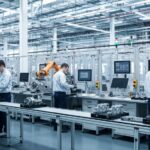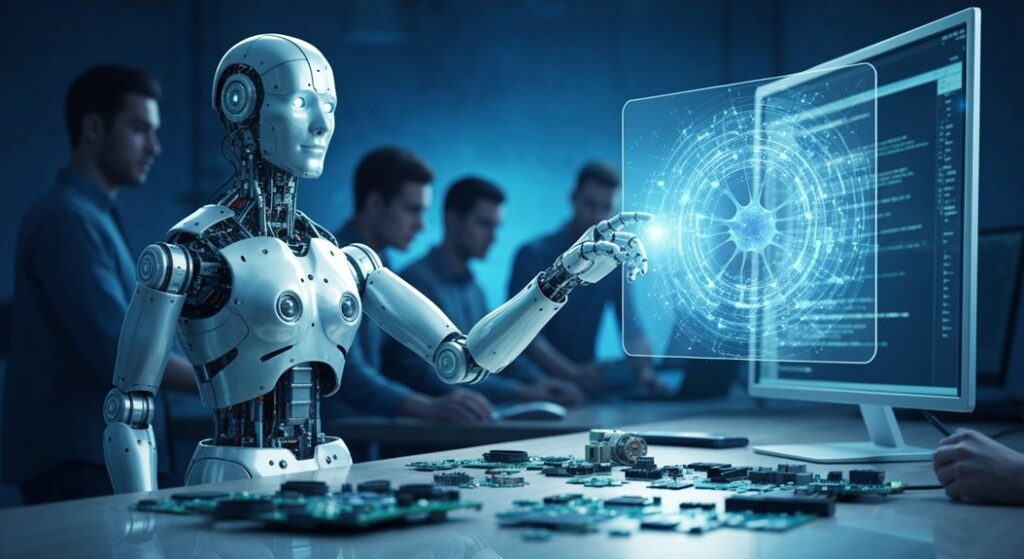
Why Embrace Automation in Modern Manufacturing?
Learn how automation is transforming modern manufacturing and uncover the surprising challenges that could reshape the industry’s future.
Artificial intelligence is changing how robots sense and act in the world. It helps them adapt, make decisions, and work with less human help. As efficiency and precision become more important, AI’s role in robotics grows. There’s much more to discover check the text below for details.

By leveraging advanced artificial intelligence algorithms, robotics systems are now able to interpret complex sensory data with greater accuracy and speed.
Through sensor fusion, multiple data streams—such as visual, auditory, and tactile inputs—are integrated to create a coherent representation of surroundings.
This enhanced environmental awareness allows robots to perceive obstacles, navigate dynamic spaces, and adapt to changing conditions, considerably improving their ability to interact with real-world environments.
Artificial intelligence enables advanced decision-making and autonomy by leveraging machine learning algorithms to interpret and analyze vast amounts of data.
Through efficient data processing, robots can assess situations, weigh options, and execute actions independently.
This integration reduces reliance on pre-programmed instructions, empowering robots to make informed choices in real-time, thereby improving their operational efficiency and versatility.
As robots operate in unpredictable and ever-changing environments, adaptation becomes essential for sustained performance.
Artificial intelligence enhances environmental adaptability by enabling machines to interpret and respond to changes in real time. Through dynamic feedback mechanisms, AI-equipped robots can assess new obstacles or shifting conditions, adjusting their actions accordingly.
This capability guarantees that robots remain functional and efficient, even as their operational surroundings continuously evolve.
Although technological advancements have expanded robotic capabilities, effective collaboration between humans and robots hinges on seamless communication. Artificial intelligence enables robots to interpret human intent and behaviors, resulting in improved user experience and more intuitive interfaces. The table below highlights key factors contributing to efficient human-robot interaction.
| Factor | Impact |
|---|---|
| Natural Language Processing | Enhances communication |
| Gesture Recognition | Improves interface intuitiveness |
| Context Awareness | Personalizes responses |
| Learning User Preferences | Tailors user experience |
| Real-Time Feedback | Facilitates rapid adaptation |
By leveraging artificial intelligence, robotics in manufacturing and logistics achieves heightened efficiency and adaptability.
AI-driven robots enable automated assembly lines to quickly adapt to product changes and variations, reducing downtime and human error.
In logistics, advanced algorithms facilitate inventory optimization, ensuring accurate stock levels and minimizing shortages or overstock.
These capabilities streamline operations, lower costs, and allow organizations to respond rapidly to shifting market demands.
AI equips robotic systems with the ability to monitor their own performance and detect potential issues before failures occur.
Through predictive analytics, these systems analyze operational data, allowing them to anticipate maintenance needs and identify patterns linked to wear or malfunction.
Fault detection algorithms can recognize deviations from normal behavior, enabling timely interventions.
This proactive approach minimizes downtime and extends the lifespan of robotic assets.
Through advanced algorithms and real-time data processing, artificial intelligence enables robots to coordinate actions, share information, and adapt to dynamic environments collectively. AI fosters cooperative strategies, allowing multiple robots to collaborate efficiently. Swarm intelligence draws inspiration from nature, enabling groups to solve complex tasks that individuals cannot handle alone.
| Key Concept | Description |
|---|---|
| Cooperative Strategies | Robots work together toward objectives |
| Swarm Intelligence | Collective problem-solving approach |
| Real-time Adaptation | Immediate response to changes |
| Information Sharing | Seamless communication among robots |
While robotics has long played a role in service and healthcare settings, recent integration of advanced artificial intelligence is transforming both fields at an unprecedented pace.
Intelligent robotic assistants now deliver personalized care and improve operational efficiency.
Key innovations include:
Integrating artificial intelligence into robotics fundamentally transforms the field by expanding perception, autonomy, and adaptability. Through advanced sensing, decision-making, and seamless human-robot interaction, AI-driven robots operate more efficiently and intuitively across diverse industries.
This integration not only streamlines manufacturing and logistics but also enables predictive maintenance, collaborative robotics, and innovations in service and healthcare.
Ultimately, AI empowers robots to respond intelligently to complex environments, maximizing their effectiveness and broadening their impact on society.